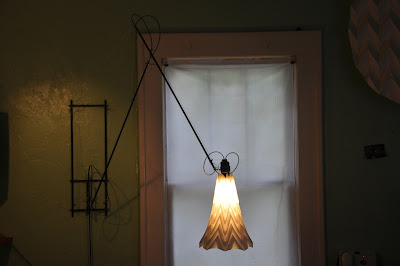I've been developing these counterweighted lamps for about 2 months now. It started when our couch became an epicenter for handwork. I have always worked on various things there, but the fact that our friends started knitting and drawing there meant that we needed more specific lighting to accommodate the detailed work. I made the
first one and started on the second one right after it was done. The second time around, it went a lot faster to do the arm. My sitting and staring time was far reduced because I'd already designed the fittings for the arm. The base was a different story. I wanted to move away from the wood base in the first lamp and make one using a consistent set of materials - carbon tubes and stainless wire. I figured this would unify the design, and I think it has. The next one will have a more shapely base, although I do enjoy this one.

.jpg)
I use the beautifully precise bearing in dead hard drives for the main counterweight - I strip parts out until I have the right weight, then I drill a hole in the top and feed the spectra around the center drum. This handles movement for two points in the articulated structure - the top point and the mid point. The lamps can be adjusted with very minimal force - two fingers to any position within their range.
In developing these stainless wire fittings for carbon tubes on both kites and lamps, I have really felt tested by the material. It is a real study in minimalism. These lamps have the smallest amount of wire that I could possibly use. What look like flourishes on the fittings are just clean ways to deal with the ends of wire that don't involve stabbing the user. The wire is both very forgiving, and totally relentless in the demand for precision. The annealing is absolute and wonderfully consistent when the wire first comes out of the can, but as soon as you commit to a bend that is beyond that limit, the wire hardens, never to return to the soft state that it started in. You have to work in one direction. There is no going back and adjusting certain aspects of the form.



.jpg)


















.jpg)
.jpg)
.jpg)






.jpg)
.jpg)

















